 “Get ‘em while they’re young.” – John Curdo “Get ‘em while they’re young.” – John Curdo
John told me this at a Billerica Saturday Swiss (who remembers Honeywell?) back in the late 1980’s after beating one of countless young upstarts. The point was, of course, that kids often improve rapidly, and if you don’t beat them while they are still young, you may not get another chance. Many of the kiddies leave chess before they get good or soon after, but many stick around and become good players. Of course when Curdo said this, it did not occur to me that he may be talking about me, too. My results against the New England legend have certainly improved over the years, but I still have an insurmountable negative score against him. He certainly got me while I was young…
There are many young players in the U.S. who are now Grandmasters that I played when they were less well known. I played Josh Friedel in a simul when he was around 8, and I beat him (for the first and last time) when he was about 2170. In these pages the reader may have noticed that I played Ray Robson twice – losing both games – when he was younger. I have never played Hikaru Nakamura in a tournament game, but my friends Joe Fang and Nathan Resika both have, and they both beat him. It’s all in the timing. I played in tournaments in Budapest in 2000 and 2003 and played the likes of future-GM’s Csaba Balogh and Tamas Banusz. I drew both of these games, which was not so special at the time, but I also played a couple of better known players who were coincidentally also named David…
David Vigorito, (2300)
David Howell, (2250)
[A26] English Opening
Elekes Memorial (5), 21.05.2003
At the time of this game, David Howell was only about 12 or 13 years old. He was rated 2250, but he was improving rapidly and was 2323 on the next rating list. David had already earned a bit of a name for himself, as he played a blitz match against then World Champion Vladimir Kramnik. Although he lost (surprise) 3.5-.5, he drew a game and this was allegedly some sort of record for the youngest player to ever draw an active World Champion. I was a little higher rated and White, but I was still scared of him. My good friend Joe Fang and I were staying together for the tournament. Joe tried to reassure me, “he’s just a little kid.” I replied, “yes, but he has sharp teeth and claws!”
1.c4
Howell’s favorite opening was and still is the Grunfeld, and I did not have much confidence facing it against a young tactician.
1…e5 2.g3 Nc6 3.Bg2 g6 4.Nc3 Bg7 5.e4 d6 6.Nge2 f5 7.d3 Nf6 8.0–0 0–0 9.Nd5 Ne7
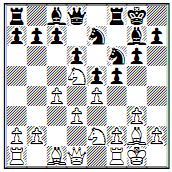
The Botvinnik English was an opening I felt comfortable playing, as I had used it when I was younger (I did not start playing in real tournaments until I was 16) at the Billerica Chess Club.
10.Be3?!
But I make a mistake immediately and allow Black to seize the initiative. Better is 10.Nxf6+! Bxf6 11.Bh6 (11.d4 was recommended by Kosten) and White has easy development after either 11...Rf7 12.Qd2 or 11...Bg7 12.Bxg7 Kxg7 13.Qd2.
10...Nexd5!
Now Black is able to exchange off his less active knight.
11.cxd5 f4!
A well timed pawn sacrifice. Instead 11...Ng4 12.Bd2 f4 13.f3 Ne3 14.Bxe3 fxe3 is not so clear
12.gxf4 Ng4
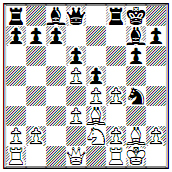
13.h3!
I already recognized the danger and spent 38 minutes here. I calculated a couple of lines which still look accurate in 2011:
a) 13.Qd2 Qh4 14.h3 Nxe3 15.fxe3 Bxh3 16.Bxh3 Qxh3 17.Rf2 Rf7 and with a safer king, Black is at least a little better.
b) 13.Bc1? Qh4 14.h3 Nh6 15.fxe5 Bxe5 gives Black a very strong attack:
b1) 16.f4 Bxh3! 17.fxe5 Bxg2 18.Kxg2 Ng4
b2) 16.d4 Bxh3!! 17.dxe5 Ng4 18.Bf4 Bxg2 19.Kxg2 Rxf4 20.Nxf4 Qh2+ 21.Kf3 Rf8
13...exf4?!
This is a mistake, based on Black’s next error. Instead 13...Nxe3 14.fxe3 exf4 15.exf4 Bxb2 16.Rb1 Bg7 would be unclear. Black has the bishop pair while White has more space and center pawns.
14.Bxf4
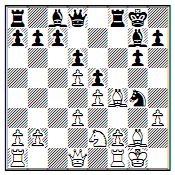
14...Rxf4?
This is just too much. I made a mistake on the 10th move, but that’s it. Black can not just overrun White after one mistake. Better was 14...Ne5 when Black at least has a little bit of compensation for the pawn.
15.Nxf4 Be5 16.Ne6 Bxe6 17.dxe6 Nh2
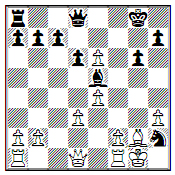
This does not really do much. White could even play 18.Re1. Even after 18…Qh4 Black does not really have anything other than some dark squared control for the exchange and a pawn. But White has a better way
18.f4!
This returns some material but White seizes the initiative for good.
18…Nxf1 19.fxe5 Ne3 20.Qf3 Nxg2
There is no need to recapture the knight yet, so White can proceed with the attack.
21.Qf7+ Kh8 22.e7 Qg8
Instead 22...Qe8 loses after
23.Qf6+ Kg8 24.Rf1 Ne3 25.Qe6+ Kg7 (or 25...Kh8 26.Rf7) 26.Rf8. 23.Qf6+ Qg7
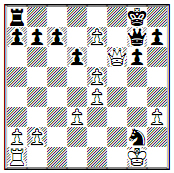
24.Rf1! Rg8 25.Kxg2 dxe5
After 25...h5 I had calculated 26.e6 (26.Qf8 also wins) 26...Kh7 27.Qxg7+ Kxg7 28.Rf7+ with the idea Rf8.
26.Qf8 1–0
In Budapest I played a few game against the Berczes brothers. Csaba was older and stronger on my first trip in 2000, but in 2003 his younger brother David had been showing rapid improvement. Now David is a 2550 rated GM.
David Berczes, (2324)
David Vigorito, (2298)
[D17] Slav Defense
FSIM June Budapest HUN (4),
10.06.2003
1.d4 d5 2.c4 c6 3.Nf3 Nf6 4.Nc3 dxc4 5.a4 Bf5 6.Ne5
This is the critical line of the Slav. White intends to build a big center with f3 and e4, when the f5-bishop will be locked out of play. The main lines are very complicated and theoretical and I was not ready for them. I decided to play a sideline that my friend IM Cyrus Lakdawala had played with success. My preparation for this game was based on playing through some of Cyrus’s blitz games on the ICC!
6...Na6
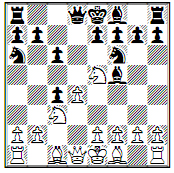
Really this move is probably a bit dubious and Black is better off with the main continuations 6…e6 and 6…Nbd7. Its main virtue is that it sets a trap that White is likely to fall into if he is not familiar with the line.
7.f3?!
This is the trap! The problem is the quiet 7.e3! which I faced when I dared to repeat this line against GM Dash. He played this instantly and already I regretted my opening choice. 7...Nb4 8.Bxc4 (this line can also come about from the move order (6.e3 Na6 7.Bxc4 Nb4 8.Ne5) 8…e6 (of course not 8...Nc2+ 9.Qxc2! Bxc2 10.Bxf7#) 9.0–0 Bd6 10.f4 h6 11.Qe2 Bc7 12.g4 Bh7 13.f5 Nbd5 14.e4 Nb6 15.Be3 Bxe5? 16.dxe5 Nxg4? 17.fxe6 Nxc4 18.exf7+ Kf8 19.Bc5+ 1–0
D.Sharavdorj-D.Vigorito, Las Vegas 2005. Ugh.
7...Nd7!
Black is looking to play a quick …e5 to exploit his better development and the weaknesses that White has created on the dark squares with the move 7.f3!?
8.Nxc4
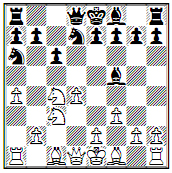
If 8.e4 Nxe5 9.dxe5 (one trap is 9.exf5 Nd3+ 10.Bxd3 cxd3 11.Qxd3 Nb4 with the idea 12.Qd1 Qxd4!) 9...Qxd1+ 10.Nxd1 Be6 and Black stands very well. Black is also happy after 8.Nxd7 Bxd7 9.e4 e5! 10.Bxc4 (or 10.dxe5 Be6) 10...exd4 11.Qxd4 Nb4. White’s weaknesses on the queenside come back to haunt him. This is one point of the Slav for Black – White weakens his queenside with the move 5.a4 and must not lose the initiative or he can run into trouble.
8...e5! 9.e4
Instead 9.dxe5 loses a piece to 9… Qh4+ 10.g3 Qxc4. White gets it back after 11.e4 , but Black is still doing well after 11…Qe6 12.exf5 Qxe5+. White is certainly not better after 9.Nxe5 Nxe5 10.dxe5 Nb4 11.e4 Be6.
9...exd4 10.exf5
After 10.Qxd4 Nb4! 11.Qd1 (White should try 11.Na3 Be6 when Black is only a little better) 11...Be6 and Black intends ...Nc5 when the weaknesses of the b3- and d3-squares give Black a big advantage.
10...dxc3 11.bxc3
The tactical try 11.Qe2+ Be7 12.Nd6+ Kf8 13.Nxb7 loses after 13…Qb6 14.Qxa6 (14.bxc3 Re8!) 14...Bh4+! (14...cxb2 wins too) 15.g3 Re8+ 16.Kd1 (16.Be2 Qxa6) 16...Qb3 mate!
11...Qf6
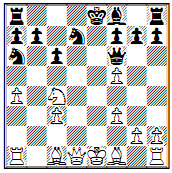
This was an idea I got from Cyrus’s blitz games. Black will castle long and bring both rooks to the center. The game has a very classical feel to it (for Black!)
12.Qc2 0–0–0 13.Be2 Bc5
This prevents White from castling, but 13...Nb4 is strong too.
14.Rb1 Rhe8
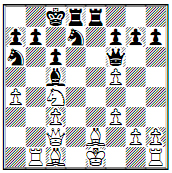
White’s position is in shambles. My opening experiment worked (this once, at least) against a 2300+ FM opponent. In this kind of tournament, it is important not to lose when norm-hunting, while a win with Black was very big, especially as I had drawn my first three games.
15.Kf1?
This just loses time. The sad moves 15.g3 (intending Kf1-g2) and 15.h4 (stopping …Qh4) were better attempts at survival.
15...Qh4 16.g3 Qh3+ 17.Ke1 Qg2 18.Rf1 Nf6 19.Qb2
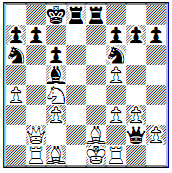
White gets to threaten mate.
19...Nb4!
Black threatens …Nd3+ and White is mated after 20.cxb4 Bxb4+
21.Qxb4 Qxe2#
0–1
IM David Vigorito is the author of several highly acclaimed books. Signed copies are available, and he can also be reached for private and group lessons, lectures, and exhibitions at dvigorito@msn.com.
|